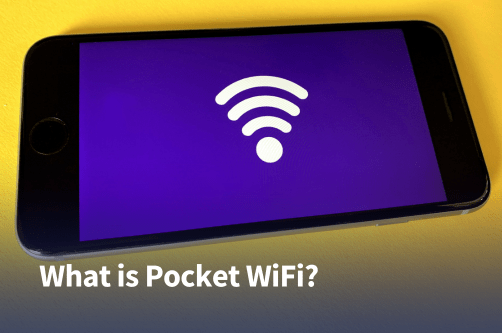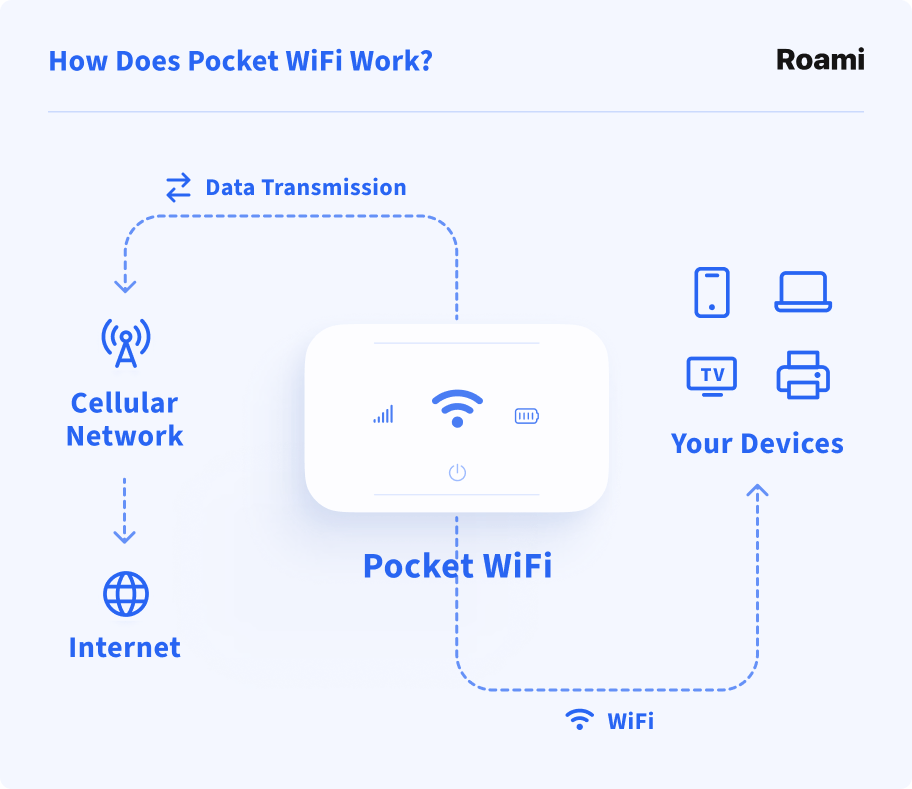Traveling through Europe in 2025? Don’t let slow or insecure connections ruin your trip. In this...
Mobile Internet
In this post, we will deeply explore what Pockets WiFi are, how they work, how much they cost, and what are the alternatives.


Pocket WiFi is a small device that connects to the local network via a wireless connection. You can use it as a hotspot to connect your smartphones, laptops, tablets, and other devices to the internet and surf the web.
Also known as a WiFI puck, WiFi egg, or portable hotspot, these handy devices are perfect for travelers. They’re a cost-effective way to connect to the local network without eating your data, and they’re super simple to use!
In this guide, we’ll answer questions like:
And more. Let’s dive in!
Think of how you use your WiFi at home–you need a router that plugs into the wall and emits the signal throughout your space. Portable WiFi is fairly similar, except it’s a small device that can fit in the palm of your hand (or in your pocket).
WiFi pucks are also portable, which means you can carry them around and connect your devices to the internet anywhere. You can use your phone as a hotspot, of course, but this eats at your data and can result in a hefty phone bill. Meanwhile, pocket WiFi allows you to get a strong and stable connection wherever you are in the world, without using the data from your plan.
Some WiFi eggs are perfect for use in certain areas. For example, you can get pocket WiFi in New York from several providers. Others are ideal for traveling, with options for pocket WiFi in Europe that work well in several countries. Make sure you get the right option for you!
The next question is: how do WiFi pucks work?
A lot of people wonder how to use pocket WiFi, but you need to understand how it works first. WiFi eggs transform a 3G or 4G connection into a private WiFi signal, or a hotspot. It generates a WiFi radio field of around 10-15 meters, allowing you to connect wirelessly.
In fact, depending on the device, you can sometimes connect up to ten other devices and surf the web at the same time! So, how does portable WiFi actually work? Well, it needs a SIM card that can connect to the wireless local area network (WLAN). It’s an ideal option for using internet abroad, though, because it means you can connect to the local network without having a data plan for your phone.

Does portable WiFi work without service, then? The answer is no. No data roaming option is perfect, and there are pros and cons to each.
Hopefully, by now you can answer the question how does a portable WiFi router work? But what are the pros and cons of using one? Is there a better option?
Pocket WiFi is a convenient solution for staying connection on the go. It has several attractive benefits:
Despite these advantages, there are also some downsides.
Using pocket WiFi is actually straightforward; you just need to follow the instructions below.

Remember to turn the device off when it’s not in use, or you’ll waste the battery. And, another tip: keep an eye on the data usage!
The cost of pocket WiFi can vary quite widely depending on whether you buy or rent the device. Some providers also require you to get insurance to cover the rental, and of course, the rate depends on the data plan you get. Options like Travel WiFi are available for as little as $55.65 per week, whereas unlimited plans like Cello Mobile cost $104.93 for a week.
Considering getting a WiFi egg for your next international trip? Keep these factors in mind to ensure you’re making the right decision.
Pocket WiFi is far from the only option you have when traveling internationally. Another popular option is an international eSIM. This is an affordable alternative that means you can connect a singular device (like your cellphone) to the local network of your destination. It doesn’t require a physical SIM slot, which means you can switch to the local provider with ease.
Considering an eSIM? We recommend Holfaly!
Alternatively, you can try a local SIM card. This involves purchasing a physical SIM card from your destination and inserting it into your phone. In many ways, this is a less convenient option, but it can be cheap if you’re traveling to just one place.
For some web users, international roaming is an option. This involves using your data plan from your usual provider in another country. However, the costs can quickly add up.
The final option is public WiFi. Most cities have places where you can connect to a WiFi network for free. While this is cheap, it means you don’t always have access, and there are some cybersecurity concerns.
Here’s a table to help you compare these options.
Compare these pocket WiFi alternatives to see which option is best for you.
| Features | Pocket WiFi | International roaming | eSIM |
| Sharing data with multiple devices | Yes | No | In some cases |
| Portability | Yes | Yes | Yes |
| Pricey | Yes | Yes | No |
| Data limitation | Yes | Depends on the plan | Depends on the plan |
| Maintenance | Yes | No | No |
| Need for constant charging | Yes | No | No |
| Convenience | Medium | High | High |
| Use of regular telephone number | No | Yes | No |
| Potential hidden charges | No | Yes | No |
| Dependence on the home operator’s network | No | Yes | No |
| Low-cost | No | No | Yes |
| Easy installation | No | Yes | Yes |
| Large coverage | Depends on the model | Depends on the operator | Yes |
| Need for a compatible device | No | No | Yes |

Numerous providers offer pocket WiFi, and you can rent a device from a vast array of options such as Cello Mobile. Generally, renting is a far cheaper and more convenient option, as you won’t use your device at home. Make sure you look for a device that covers the location you’re traveling to.
The cost of pocket WiFi varies depending on a range of factors, including the duration of the rental and the data plan you choose. There’s also the shipping and return costs, insurance, and more. The cheapest options can be as little as $40 for a week, but if you want unlimited data, you’re looking at $100+.
Yes, pocket WiFi works in most countries. However, it’s important to check that the device you’re buying is compatible with the country’s network before you buy or rent it. Some devices don’t work in some regions due to network restrictions.
If you rent a pocket WiFi, chances are that loss or damage will result in a fine. Your provider will usually list these fines on their site, so check there to find out how much you owe. To avoid these problems, it’s important to handle your WiFi egg carefully and keep it safe.

